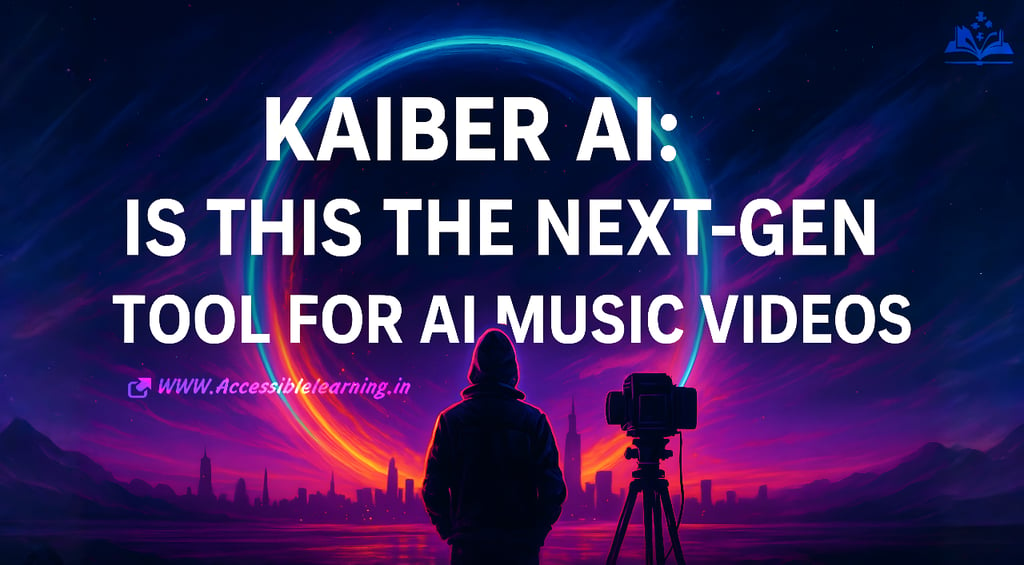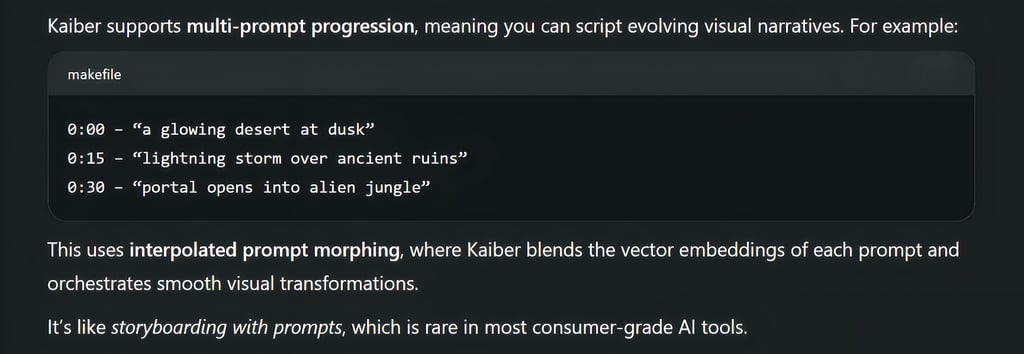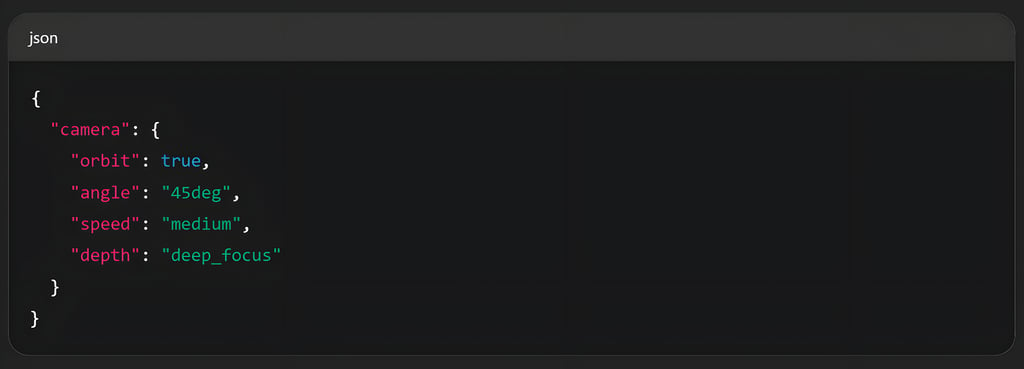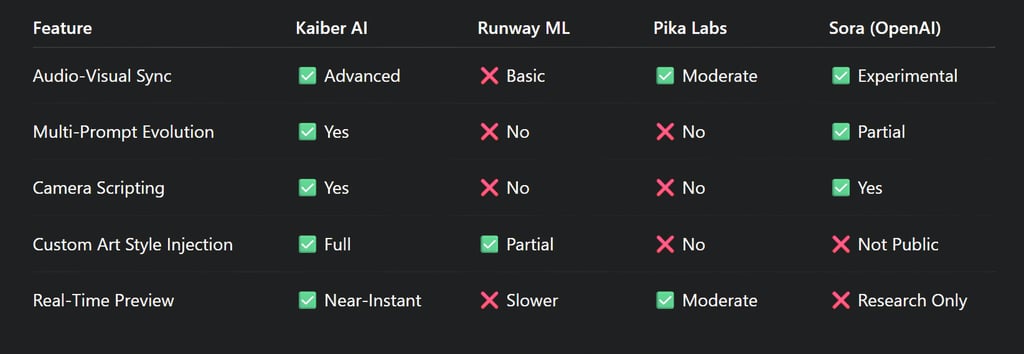
Kaiber AI: Is This the Next-Gen Tool for AI Music Videos?
Explore how Kaiber AI is revolutionizing AI music videos with beat-sync visuals, multi-prompt storytelling, and camera scripting. Is this the future of video creation for artists and musicians?
AI ASSISTANTAI/FUTUREAI ART TOOLSARTIST/CREATIVITY
Sachin K Chaurasiya
6/17/20255 min read


In the evolving landscape of artificial intelligence and creative media, a fresh wave of tools is democratizing artistic expression—and Kaiber AI is leading that charge, especially in the realm of AI-generated music videos. But is it just another flashy tool or the future of video content creation for artists?
Let’s dive deep into what Kaiber AI is, how it works, and whether it’s truly poised to become a next-gen platform for musicians, content creators, and visual artists.
What is Kaiber AI?
Kaiber AI is a generative AI tool that transforms text prompts, still images, and audio into dynamic, visually rich video content. Think of it as your own creative director powered by machine learning. From surreal landscapes to cyberpunk animations, Kaiber allows artists to design cinematic-quality visuals using simple inputs.
It gained massive traction after being used by artists like Linkin Park for their official AI-generated music video for “Lost.” That moment marked a cultural shift: AI was no longer just a concept in labs—it was now making waves in mainstream media.
How Does Kaiber AI Work?
At its core, Kaiber leverages text-to-video AI models combined with advanced image-to-video techniques. Here’s how the process works:
Prompt-Based Input: Users describe a scene using natural language or upload a reference image.
Audio Integration: Upload a song or audio clip.
Style Selection: Choose from curated styles like Anime, Cyberpunk, Synthwave, or hand-drawn aesthetics.
Render & Refine: Kaiber processes the request and generates a unique video aligned with the audio’s mood and rhythm.
Users can control camera movement, scene transitions, and even specific animation effects, creating a semi-directorial experience—without needing editing software like Adobe Premiere or Final Cut Pro.
Why Kaiber AI is Gaining Popularity
Accessibility for Musicians & Indie Creators
Professional music videos can cost thousands of dollars. Kaiber gives indie artists a way to create high-quality visuals for their tracks at a fraction of the cost—and in a fraction of the time.
Creative Freedom Without Technical Skills
You don’t need to be a video editor, animator, or visual effects expert. Kaiber empowers creators with drag-and-drop simplicity and AI-enhanced creativity.
Community & Collaboration
Kaiber has cultivated a vibrant creator community. Users often share workflows, remix each other’s videos, and even collaborate across genres and disciplines.
Pros & Cons of Kaiber AI
Pros
Easy to use, no editing background needed
Affordable alternative to professional music video production
Wide range of artistic styles
Ideal for social media content, teasers, and music promotions
Quick turnaround time for video generation
Cons
Not yet suited for full-length, high-budget productions
Limited control over micro details in animation
Style choices may feel repetitive across different users
Subscription model might be expensive for occasional users
Is It the “Next-Gen” Tool for Music Videos?
In many ways, yes—Kaiber represents a major step forward in AI-generated content. It has lowered the barrier to entry for visual storytelling, especially for musicians and creators on a budget. Its ability to align visuals with music beats, evoke mood through style, and generate videos in minutes makes it incredibly powerful.
However, Kaiber is not a replacement for traditional filmmaking or professional animation—for now. It’s a complementary tool that fits into a hybrid creative workflow, especially in the age of TikTok, YouTube Shorts, and Spotify Canvas.

Technical & Advanced Insights into Kaiber AI
Cross-Modal AI Architecture
At its core, Kaiber AI operates on multi-modal AI models—algorithms that understand and process text, audio, image, and video data together. Unlike typical single-stream models, Kaiber fuses
CLIP-like architectures for prompt comprehension (text/image embedding)
Diffusion models for generating high-fidelity frames
Audio-reactive layers to link beat, tempo, and waveform peaks to motion triggers
This fusion results in dynamic visuals that visually respond to audio patterns, such as bass drops triggering camera shakes or transitions.
Beat-Sync Mechanism with Audio Fingerprinting
Kaiber doesn't just slap visuals on music—it analyzes and fingerprints audio tracks using techniques like:
Spectral Flux Analysis (to detect beat changes)
Mel-Frequency Cepstral Coefficients (MFCCs) for mood detection
Rhythmic segmentation to divide the video into timed, story-like segments
This beat-synced intelligence ensures that visuals crescendo with choruses or slow down during ambient bridges—mirroring the emotional wave of the track.
Latent Consistency for Stylized Frames
Unlike raw diffusion tools that may cause flickering or frame inconsistency, Kaiber implements latent consistency techniques:
Keyframe anchoring every few seconds to stabilize artistic transitions
Optical Flow Guidance to ensure motion coherence
Temporal embedding vectors that preserve object orientation and lighting over time
These ensure that animated characters, landscapes, or avatars don’t morph undesirably from frame to frame—especially important for longer videos.
Style Adaptation via Transfer Learning
Kaiber allows users to import custom reference art styles, which the system interprets through style transfer models trained on both:
VGG-style neural networks for low-level texture transfer
Vision Transformers (ViTs) for global composition mimicry
This gives users unprecedented control over video aesthetics—ranging from a Van Gogh-style starfield to an Akira-inspired cyberpunk city—beyond presets.
Dynamic Prompt Injection & Scene Evolution


GPU-Accelerated Real-Time Preview
While many tools make you wait minutes or hours for renders, Kaiber has integrated NVIDIA TensorRT and ONNX Runtime optimizations. This enables:
Fast previews of individual frames or clips
Live adjustments without starting from scratch
Efficient rendering through cloud-hosted GPU arrays (often using A100s or H100s for premium plans)
API Access & Automation for Power Users
Though still in limited beta, Kaiber is offering API integrations for automation:
Batch video generation for entire music albums
Programmatic style control for label managers
Webhook support for apps, live shows, or streaming setups
This makes Kaiber a viable choice for labels, agencies, and developer-artists wanting backend integration into creative pipelines.
Custom Camera Rig Scripting (Pro Feature)
Advanced creators can now use Kaiber's camera rig scripting, a JSON-based schema to define:
Zoom depth
Parallax effects
Dolly movements
3D camera orbiting
This gives you director-like control over how scenes unfold—turning static prompts into almost cinematic sequences.
Example:




Research-Level Capabilities Kaiber May Soon Integrate
Neural Radiance Fields (NeRFs): For true 3D scene construction from single images
Hyperparameter Exposure: Offering advanced users control over noise scales, seed values, and inference depth
Dynamic Voice-to-Visual Syncing: Turning spoken-word content into visual poetry or animated narratives in real time
Use Cases: Who Should Try Kaiber AI?
Indie Musicians—Build stunning music videos without hiring a crew
Podcasters & DJs—Create animated backdrops for audio content
Visual Artists—Turn art into immersive video experiences
Marketers—Use short AI videos for ad campaigns and social media
YouTubers & Streamers—Add engaging intros, visuals, and loops
Kaiber AI isn’t just a tool—it’s a creative partner. As AI becomes more intuitive and customizable, tools like Kaiber will become integral to the music video creation process—especially for those with big visions and small budgets.
If you're a creator hungry for innovation and cinematic visuals without the overhead of traditional production, Kaiber AI is absolutely worth exploring. It might just be the future of music videos—one prompt at a time.
FAQs
Q: Is Kaiber AI free to use?
Kaiber offers free trials with limited exports. Full features require a subscription.
Q: What kind of music works best with Kaiber?
Ambient, EDM, hip-hop, lo-fi, and instrumental tracks often sync beautifully due to rhythmic visual rendering.
Q: Can I use it commercially?
Yes, Kaiber provides commercial licenses depending on your subscription plan.
Subscribe To Our Newsletter
All © Copyright reserved by Accessible-Learning Hub
| Terms & Conditions
Knowledge is power. Learn with Us. 📚


